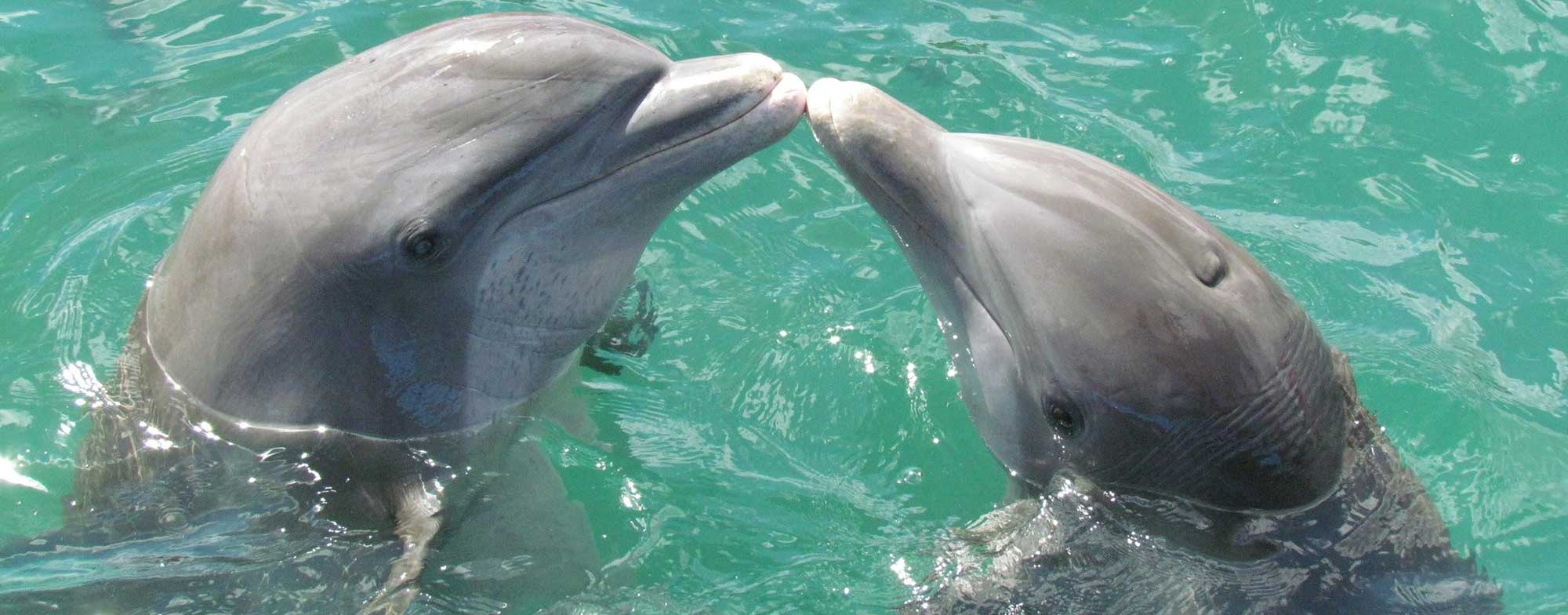Somefin in the Water: The Bottlenose Dolphins of the Potomac
MDI Seed Grant Spotlight: Janet Mann. To conduct their research, Mann and her team head out onto the water with their camera and small skiff, Ahoya, to track the Potomac dolphins.

In July of 1844, a pod of bottlenose dolphins were discovered in the Potomac River. Since then, the dolphins went largely unnoticed until Janet Mann, a Georgetown professor of biology and psychology and an expert on bottlenose dolphins, discovered a pod of them swimming near her cottage in Northern Virginia. With the help of her MDI Seed Grant, Dr. Mann launched the Potomac-Chesapeake Dolphin Project (PCDP)in 2015 to research how disease transmission follows social behavior and network dynamics in gregarious species.
The PCDP aims to better understand and protect the bottlenose dolphins of the Potomac River and Chesapeake Bay. It researches the dolphin’s disease risk, population structure, and migration patterns. The team includes undergraduate and graduate students at the university, and Dr. Shweta Bansal, an associate professor of biology at Georgetown who serves as the project’s disease ecologist and modeler. With Dr. Bansal, PCDP aims to understand the socio-environmental drivers of disease transmission among bottlenose dolphins, and other social species.
In their publication titled Disease Implications of Animal Social Network Structure: A Synthesis Across Social Systems, authors Mann, Bansal, and Sah conducted a quantitative comparative analysis across forty-seven animal species – among these the bottlenose dolphins – to investigate whether social network organization alone, without the presence of physiological or behavioral immune responses, can reduce the disease costs of group living for various social systems. They hypothesized that a social species can mitigate disease costs associated with group living through the organization of their social structure, but acknowledged that the presence of alternate disease defence mechanisms can also play an important role. For their particular examination associated with species social system, it required a comparative approach to isolate unique structural characteristics of social connections, while controlling for population size, data collection methodology, and recorded interactions.
The results described in their work indicates that highly fragmented social networks of gregarious species, of which the bottlenose dolphin is a included, experienced frequent epidemics of highly contagious infections, and longer epidemics of moderately to highly transmissible pathogens. It appears that infection spread in highly fragmented networks gets localized within socially cohesive subgroups, which enhances local transmission but causes structural delay of global infection spread. Additionally, highly transmissible pathogens are able to avoid stochastic extinction in fragmented networks by reaching “bridge” nodes, but experience delay in transmission due to the presence of structural bottlenecks. This research aids in broadening the scope of network analysis from being just species-specific to a meta-analytic approach, as it was done by Mann and her collaborators. This specific aspect of PCDP’s research provides new insights towards how the organization of interaction patterns can mediate disease costs of sociality. Mann and her team currently have several other publications on this topic and manuscripts in preparation, and this specific aspect of PCDPs research has since garnered funding from the Campbell Foundation, American Wildlife Conservation Grant, and the Repass-Rodgers Family Foundation.
PCDP has continued to research the bottlenose dolphin population, recently collaborating with Google’s artificial intelligence engineers to develop a fin-matching system within their new Cloud AutoML that successfully identifies the dolphins despite the image quality or photograph angle. Along with this cataloging system, PCDP uses systematic surveys of the lower Potomac waters to match the Potomac dolphins with those found in other locations along the Mid-Atlantic coast to see how many dolphins traverse the Potomac-Chesapeake system.
Mann’s research has accrued several publications, and has been published and featured in The Washington Post, among other news outlets and journals. Their work is unique to these waters, and provides much-needed research to conservation efforts.
Publications: Powell, S., Bansal, S., Wallen, M. M., Miketa, M. Krzyszczyk, E., Mann, J. (in revision) Disease implications of sociality among bottlenose dolphins in Shark Bay, Australia. Behavioral Ecology.
Leu, S., Sah, P., Krzyszczyk, E., Jacoby, A., Mann, J., Bansal, S. (in revision). Sex, synchrony and skin contact: Integrating multiple behaviors to assess disease risk. Journal of Animal Ecology.
Powell, S., Wallen, M.M., Bansal, S., Mann, J. 2018. Epidemiological investigation of tattoo-like skin lesions among bottlenose dolphins in Shark Bay, Australia. Science of the Total Environment , 630: 774-780
Recent Conference Presentations: Powell, S., Wallen, M. M., Bansal, S., Mann, J. 2018. Epidemiological investigation of tattoo-like lesions among bottlenose dolphins in Shark Bay, Australia. SEAMAMMS, Myrtle Beach, South Carolina, March.
Powell, S., Wallen, M. M., Bansal, S., Mann, J. 2017. Prevalence of black spot disease among bottlenose dolphins in Shark Bay, Australia. 12th International Mammalogical Congress, Perth, W. Australia, July.
Jin, Y.K., Wallen, M., Patterson, E., Bansal, S., Mann J. 2016 Synchronous breathing and its implications for disease transmission in bottlenose dolphins, European Cetacean Society, Spain.
- Tagged
- MDI